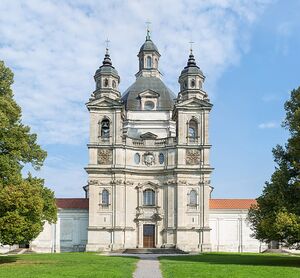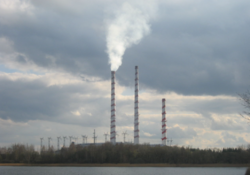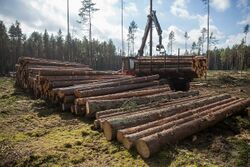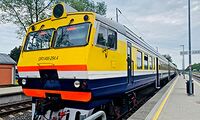Baltica: Difference between revisions
m (→Economy: spelling; layout; code cleanup) |
m (→Energy) |
||
| Line 162: | Line 162: | ||
{{Pie chart | {{Pie chart | ||
| thumb = right | | thumb = right | ||
| caption = | | caption = Energy mix in Baltica. | ||
| other = | | other = | ||
| label1 = Coal | | label1 = Coal | ||
Revision as of 09:37, 7 September 2022
United Federation of Baltica Jungtinė Baltijos Federacija | |
|---|---|
Motto: "If god is with us, who is against us ?" | |
Anthem: "The New Republic" | |
| Capital | Kauni Sveaja |
| Largest city | Goja, Kauni, Kretia |
| Official languages | Baltican Dolch, Ras, Dolch |
| Ethnic groups |
|
| Demonym(s) | Baltican |
| Government | Federation |
| Legislature | Central Baltican Government |
| State Seim | |
| Territorial Council | |
| Independent | |
• Establishment of the Baltican Federation AD | 2022 AD |
| Population | |
• 2022 estimate | 14,653,254 |
• 2022 census | 14,690,325 |
• Density | 38/km2 (98.4/sq mi) |
| GDP (nominal) | 2018 estimate |
• Total | 89,809,793,766 |
• Per capita | 6,129 |
| HDI (0.57) | 0.47 low |
| Currency | Zedas |
| Date format | dd/mm/yyyy |
| Driving side | right |
| Internet TLD | .Ba |
The United Federation of Baltica or simply Baltica, is a Federation composed of four Republics (Raskia, Kauni, Liplan-Kretin and Dokestva) and three Sister Republics (Myask, Govir and Belgorta). The United Federation of Baltica is a product of the Second Baltican Civil War, having formed during the conflict. It is a very loose Federation, for the large part still suffering from the cultural divide between Dolch and Ras that led to the war that created it. Currently Baltica has two capitals, an Administrative one in Kauni that is home to the Central Government and Sveaja which remains the Economic capital of the Nation. 14.6 Million people call Baltica home, the bulk of whom reside in the largest republic of Liplan-Kretin, in which over 5.7 Million people or about 40% of the total population reside.
Baltica is home to many swamps, bogs and wetlands that litter the Baltican East and South. Central Baltica remains home to the Grand Kretian Highlands, a collective of hills and mountains that are the source of many rivers that drain into the Amber Lake. The far West of Baltica is a deep Taiga, a land covered in thick forests and many lakes. Three main rivers flow through Baltica, this being the Visagris river in the South, the Liplan river in the Highlands and the grand Balandeli river that runs through Perkunia, and splits the Baltican South from the North. Baltica it self is devoid of many natural materials, but what it does posses is one of the most fertile lands in Central Argis. The Kauni river basin is one of the most fertile regions in the wurld, and has remained Balticas largest bread basket.
Baltica is still recovering from the civil war and as such its economy remains considerably smaller than it was before the war. Its current GDP Per Capita is only 6,129 Zedas, and its GDP is only 89.8 Billion Zedas. Its HDI is a pitiful 0.47, although efforts are being done to fix both the Baltican Economy, and bring it back to its former heights.
History
Prehistory
Most of Balticas initial settlement came from the migration of the “Balts”, who according to speculation, was the group or a collective of tribes that are the possible ancestors of the modern-day Ras and possibly Latovians in neighbouring Transbaltia. Although it is unknown when they entered modern-day Baltica, scientists have been able to locate what they call the “first settlement by the Balts in Baltica, this being the Vargas valley in modern-day Kauni county.
Modern-day excavations along the Central Baltican highlands as well as the Northern wetlands suggest that most of the old balts had been a largely ununified group, but had somewhat formed into a distinct culture, separate from the Latovians . This first group had no written language, so little is known about them, however, they were prone to carving “wards and “totems, most of which have been destroyed ( because they were carved out of wood) but some stone carvings exist to this day. The first written source of the modern Ras, came from the Dolchic, who would write about the Ras during their conquest of Baltica. This suggests that the Ras came after these previous Balts, although it's still unknown when the Ras would form into their culture group or even how they came to be the “only” culture group in Baltica, it's heavily suggested that they were a warring people, who either assimilated or killed of all other Baltican tribes within the region.
Dolch Crusade and Settlement
The Dolch invasions or “Crusades” against Baltica are the first well-documented events in Baltican history. Because the native Ras had no written language of their own before the invasion, most of the information about the Dolch expansion is largely not to be taken fully word for word seeing as there was a direct attempt to portray natives as barbaric and uncivilized people. The Dolch would first arrive at Baltica in 1321, capturing the first of many islands that dotted the coasts of mainland Baltica. The first of which is Saint Casimir Island, named after Saint Casimir who built the first monastery on the Island. Saint Casimir Island would act as the first Dolch haven in the Amber Lake, and it was slowly turned into a commercial hub between Southern Balticans and Dolch merchants. Slowly the two groups would become interlinked as they traded Balticas signature amber, for Iron and refined metals from the great forges of Casimir Island. To secure a more permanent settlement in mainland Baltica, and increase trade, even more, the Dolch along with some local tribes would end up conquering some territory along a minor river where they hoped to establish a port. This small settlement would come to be known as Goja, and the river on which it was built became known as the Naman.
Order of Baltishtin
In 1338 the Dolch would go on to conquer yet more lands, including the Island of Dvenis along the coast of modern-day Dokestva. The Islands of Casimir, Dvenis and the city of Goja would eventually come to be controlled by a union of so-called “Lords” known as the Order of Baltishtin. The first Leader of this order would be Lord Austen the Bloody. He would not be as kind as the Dolch merchants that came before him. Using the Ras warriors as mercenaries, he would go on to raid multiple territories along the coast of modern-day Dokestva, and would even take some territory and set up yet more cities. Among these were Tyver and Siela which became gateways to greater western Baltica. His sudden expansions would offset the delicate balance of the hundreds of small clans and tribes that made up Baltica and would bring on an age of war and conflict, as smaller tribes unified and became larger. The tribes that worked alongside the Dolch, predominantly the ones around their trade cities, would become powerful in their sense. Tribe Curlis located just East of the Dolch city of Goja would end up unifying the lands around the Svoyev river, forming the principality of Kazirinas with the help of Dolch minor nobles. Eventually, Lord Austen would go on an all-out war across the territories around Goja, successfully capturing them from the native Ras and either killing or forcing them North. Here he would form his Princedom of Goja, with his brother Bertolf taking ownership of the territories whilst Austen kept the city of Goja. When Lord Austen died in 1352, his Brother was voted as the new Lord of Baltishtin, and was officially sworn in as Lord Bertolf. He would continue his brother's conquests, helping push further North along the Naman and would establish the city of Ingute. In the West, the cities of Siela and Tyver would come to expand rapidly as they slowly began pushing out and assimilating local Baltica tribes. The two territories would even come to join borders with one another after successfully conquering the small tribe of Kestuti. Dolch was cemented as the tongue of the strong, and most tribes along the amber lake would adopt Dolch as either a status symbol or to better trade with the Dolch merchants. Money with the Dolch double-headed eagle would become all too common in lands as far as modern-day Raskia. Although Bertolfs conquests were nowhere near as large as his brothers, he would kick start a Dolch golden age in the Amber Lake, helping reaffirm the Dolch peoples place in Baltica.
Bertolfs early demise in 1374 would bring in the long reign of Lord Arnold the Conqueror. Arnold was the first lord to have been born in the Dolch territories, and his ambition was to see an Amber Lake controlled by his people. To aid in his conquest he set out a call for warriors from all over Argis to aid him in his quests and began conscripting the many men of Goja to his cause. His army grew rapidly being anywhere from 30,000-to 60,000 strong and with over 500 knights. The first ambition of the Baltishtin was to unite their Eastern and Western territories which would require them to fight the great Clan of Kretina. As Arnolds army advanced it would be met by a great army of Baltican Kretians. The infamous Knight Tilke of Tyver would write of the battle
The battle would be a decisive victory for the Dolch, and the Kretina would flee as those who couldn't were slain by the Dolch. What was left of the Kretina clan would migrate North, eventually settling the lands of Greater Kretia, but for now the lands which became known as New Janikis would become part of the Baltishtin. Unlike his predecessors, Arnold did not build cities, but fortresses. Castle Jonikis and Kavarki would become the new centres of New Janikis, built not as permanent settlements but as holdouts for troops that flooded into the region. It was only a coincidence that cities would grow around these fortresses, but it would become a common practice for Dolch nobles and lords. After the battle of Janikis, the land of Lord Arnold would then march South into the lands of the West. Using the towns of Siela and Tyver Arnold launched yet another offensive into the lands of the Balticans, this time capturing territory throughout the Liplan river. Unlike the lands of New Janikis, these territories were nowhere as nearly populated, and would most often be completely assimilated. The construction of the fortress Unmarage would mark the end of the conquests of Lord Arnold. Having obtained all lands from East to West he was satisfied but would ironically die just months later from a stroke. His death would shake the Balthistin to its core as his immense personal holdings fractured into dozens of smaller principalities and duchies. The Dolch invasion had been won but the 15th century would not be so forgiving…
Geography
Climate
The climate of Baltica is determined largely by the Amber Lake, which contributes to its typical cold climate. It is a continental subarctic climate throughout, with only small areas of the south being classified as Humid Continental Climates. The temperature is somewhat moderate considering how far north the area is. This region has a tremendous amount of variety in precipitation. Western Areas such as greater Kretia as well as the Goja region experience quite mild rainfall, roughly 50 to 100 cms of precipitation annually. However, Southern Baltica, specifically the Visagris region, experiences extreme rainfall, roughly 150-200 cms of rainfall annually, making it quite humid in comparison to the rest of Baltica. Temperatures throughout Baltica typically average at the mid 30-35 °C in the summer, whilst during winters temperatures can reach as low as -27 °C in the Western Territories. Snow is common and rivers often freeze up in the west, although in the south the quick stream prevents them from freezing.
| Climate data for Baltica | |||||||||||||
|---|---|---|---|---|---|---|---|---|---|---|---|---|---|
| Month | Jan | Feb | Mar | Apr | May | Jun | Jul | Aug | Sep | Oct | Nov | Dec | Year |
| Record high °C (°F) | 10.9 (51.6) |
11.8 (53.2) |
17.5 (63.5) |
25.5 (77.9) |
31.0 (87.8) |
31.3 (88.3) |
35.2 (95.4) |
30.9 (87.6) |
28.8 (83.8) |
21.1 (70.0) |
16.6 (61.9) |
11.3 (52.3) |
37.2 (99.0) |
| Record low °C (°F) | −32.2 (−26.0) |
−38.6 (−37.5) |
−36.4 (−33.5) |
−26.4 (−15.5) |
−18.2 (−0.8) |
−7.0 (19.4) |
−5.0 (23.0) |
−10.8 (12.6) |
−16.1 (3.0) |
−26.4 (−15.5) |
−34.2 (−29.6) |
−40.6 (−41.1) |
−51.5 (−60.7) |
| Source: Baltica Weather Administration Team | |||||||||||||
Environment
The primary territory of Baltica lies on what is known as the Western Lake Plains, with a majority of the nation being comprised of wetlands and flatlands. Roughly 21% of all land in Baltica is comprised of Swamps, Marshes, Flood plains and bogs. This is a large decrease from the once 34%, which is often attributed to both the Baltican civil war, rise of industries and the draining of these areas to make the land for cities as well as agricultural land. Besides wetlands, forests make up the other large majority of land in Baltica, making up about 41% of all land in Baltica. The largest natural forest remains the Draigai Forest, which at one point used to be much larger but due to logging in the recent decades has greatly diminished in size. However, most of these forests can only be found in Western or Northern Baltica, as areas like Visagris had undergone large deforestation and land transformation during the 1970s. Although new legislation exists to prevent the type of deforestation Baltica experienced during the late 20th century, logging and land transformation remains rapid in some regions, and the yearly loss of both forests and wetlands is still quite high.
Rivers are quite abandoned in Baltica, with over 300 rivers flowing all over the nation, the largest of which are the Kauni river in Western Baltica as well as the Uzli river in Northern Baltica. Balticas rivers have largely been uncontaminated by pollution, largely because of the lack of real industry on rivers as most Baltica industry is located on the Amber lake. Most of these rivers originate from mountains outside of Baltica itself, mainly around the Western Misty Mountain Range that makes up the Western border of Baltica. Rivers in the East mainly originate from internal Lakes and flow out into the Amber lake as well as other lakes. A few Northern Rivers originate from the Nation of Mokhavia, and Balticans Eastern border is comprised of the Belgorta river.
Politics
Government
Military
Foreign relations
Economy
Energy
Energy mix in Baltica.
Baltica has historically had a track record of poor energy production. Due to the very high instability and consistent fighting between the German Balts and the Regular Balts, multiple so-called “mega projects” have been abandoned due to the government's failure to secure both funding and materials to construct them. As such, Baltica had to mainly rely on coal, and eventually oil, for most of its energy production. The Krugiti Coal Power plant was the largest coal power plant in Baltica. For a while it was the main energy production site, supplying over 19% of all energy needs in Baltica.
However, following a large fire in 2001, the power plant had to be closed and Baltica had to begin expanding its energy variety. Currently, multiple of the “mega projects” have been pushed into the limelight. In particular, the large Ugadi Nuclear Power Plant, planned to be constructed in the city of Ugadi, and the Kretia Hydroelectric power station, a planned hydroelectric dam to be constructed on the Balandi river. Although currently these projects are only in the planning stages, if they were to be constructed they have the potential to turn Baltica into an energy exporter, and possible key player in middle Argis.
For now, about 46% of all energy in Baltica comes from coal, with 18% from oil, and 11% with Hydro. The rest make up a small minority, including: Biofuel (8.7%), Solar (8.2%), Wind (5.1%), and geothermal (3%).
Industry
For most of its existence, Baltica had been an agrarian state, mostly relying on its Southern Territories; which had strangely fertile soil, to fuel its economy. Today it still remains Baltica's largest Industry, making up over 21% of all total GDP, and employing over a million people. It's mostly known for its cheese, known as Dzugi, which almost makes up 2% of the whole economy. Dairy as a whole remains a big part of the Agricultural Sector. Strawberries, potatoes, wheat, and rye make up most of the crops produced by Baltica, rye especially, due to its use in alcohol and bread making.
Although Balticas industry is comparably small, over the recent years it has begun to specialize in manufacturing, specifically furniture. Baltica has developed a taste for constructing mostly wood made items, relying on its abundance in forested areas in the North to fuel this recent expansion. Notably, the company Uklea has created a monopoly of wood manufacturing and harvesting, and is leading Baltica to an age of economic growth. Other companies have been opened in the mostly rural undeveloped North, leading to the Northern Economic Boom.
Although Baltica doesn't produce many luxury goods, the nation has been renown for its alcohol, which some consider the best in Argis. It also led to Baltica becoming one of the highest consumers of alcohol in the world. Cigarettes also remain a very sought after commodity in Baltica, with local brand Uki being the favorite in Baltica by far; manly due to its low cost and availability. Although the fur trade is not as prevalent in Baltica as it once used to be, areas of the North are still regarded as producing some of the finest traditional fur clothing in the entirety of Argis.
Infrastructure
Most of Baltica is quite interconnected, with almost all settlements over 100 people having a main road going in and out. Despite this, much of the Northern Woodlands remain quite isolated from the rest of the Nation, partly due to a lack of population, but also the large wood coverage making it difficult to build and maintain roads and train tracks. The “National Spine” or R1, is the main road spanning much of the nation. It connects the capital, Goja to the large settlements of Kauni, Sveaja, Kretia and Visagana. It's by far the most used road network, and subsequently the most maintained. Other road networks include the RA1, a road network made for connecting the region of greater Kretia, as well as the R15, a road network connecting the southern region of Jounikis.
Rail remains the most popular form of transport in Baltica, mainly due to its availability and the fact that it's much cheaper than owning cars (Which are heavily taxed). Most of Baltica uses electric trains, although some parts of the underdeveloped North still continue to run on coal or even oil powered trains due to a lack of funds. The main rail track (A1) goes from Sveaja, Kauni and into Bazinas. This rail line continues to be the most popular by far, mainly due to it being around the industrial and agricultural hubs of the Kauni region.
The Goja track (A11), which connects Goja to Kretia and Eleania remains an important track for industry, as it connects the larger ports of Kretia and Eleania to the nation's industrial capital, Goja. In recent decades, there has been a large push to create new rail lines along the National Spine. Even today, many large cities are still not connected to one another. This forces people to use the underdeveloped bus transport to get to large cities in order to access the trains. As such, the government has responded with the announcement of the creation of the A30. This train line will connect the previously mentioned A11 and A1, as well as connect the cities of Visagana and Jounikis to the wider train line system.






